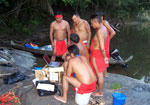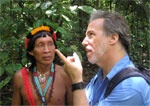The story of an indigenous Amazon tribe that has embraced technology in its fight to protect its homeland and culture is now highlighted as a layer in Google Earth.
Videos, pictures, maps, and information about the Surui, a tribe that was garnered international attention for its battle against loggers and its partnership with Google Inc., is available via Google Earth.
First exposed to the outside world in 1969 — an event that nearly resulted in their extinction due to introduced diseases — the Surui today work with Google and other partners map and monitor their territory using cutting-edge technology. While the use of technology has helped the Surui secure their land, it has unexpectedly strengthened cultural ties between young and old members of the tribe.
“Surui elders provide the traditional knowledge, while the younger generation uses the technology,” said Vasco van Roosmalen, director the Amazon Conservation Team in Brazil, an NGO that works closely with the Surui.
The Google Earth KMZ file for the Suri is available at Trading Bows and Arrows for Laptops.
Related

(07/08/2009) The Washington Monthly is featuring REDD in its July/August issue. Right now, there’s more money to be made cutting tropical forests down than leaving them standing. Environmental policymakers are trying to reverse that equation via a mechanism known as Reducing Emissions from Deforestation and Forest Degradation, which is being piloted in countries around the globe. Though REDD can take many forms, the key idea is that businesses or governments in wealthy countries compensate those in the developing world for preserving their forests, either by paying into a fund or by purchasing credits on carbon markets. Roughly one-fifth of the worlds carbon emissions stems from deforestation and forest degradation. Scientists warn that without measures to keep forests intact, we will stand no chance of avoiding catastrophic climate change.
Satellites and Google Earth prove potent conservation tool

|
(03/26/2009) Armed with detailed images from space and remote sensing data, scientists, environmentalists, and armchair conservationists are now tracking threats to the planet and communicating them vividly to the public. Posted on the e360, an online publication from the Yale School of Forestry & Environmental Studies
‘Children of the Amazon’ looks at cultural loss of Amazon tribe confronted by deforestation
(10/05/2008) ‘Children of the Amazon’, a new documentary by Denise Zmekhol, looks at the cultural transformation of the Surui and Negarote tribes following the development and improvement of a highway that penetrates deep into the Amazon rainforest of western Brazil.
Amazon Conservation Team wins “Innovation in Conservation Award” for path-breaking work with Amazon tribes
(12/11/2007) The Amazon Conservation Team (ACT) was today awarded mongabay.com’s inaugural “Innovation in Conservation Award” for its path-breaking efforts to enable indigenous Amazonians to maintain ties to their history and cultural traditions while protecting their rainforest home from illegal loggers and miners.
 |
Amazon Indians use Google Earth, GPS to protect forest home
(11/14/2006) Deep in the most remote jungles of South America, Amazon Indians are using Google Earth, Global Positioning System (GPS) mapping, and other technologies to protect their fast-dwindling home. Tribes in Suriname, Brazil, and Colombia are combining their traditional knowledge of the rainforest with Western technology to conserve forests and maintain ties to their history and cultural traditions, which include profound knowledge of the forest ecosystem and medicinal plants. Helping them is the Amazon Conservation Team (ACT), a nonprofit organization working with indigenous people to conserve biodiversity, health, and culture in South American rainforests.
 |
Indians are key to rainforest conservation efforts says renowned ethnobotanist
(10/31/2006) Tropical rainforests house hundreds of thousands of species of plants, many of which hold promise for their compounds which can be used to ward off pests and fight human disease. No one understands the secrets of these plants better than indigenous shamans -medicine men and women – who have developed boundless knowledge of this library of flora for curing everything from foot rot to diabetes. But like the forests themselves, the knowledge of these botanical wizards is fast-disappearing due to deforestation and profound cultural transformation among younger generations. The combined loss of this knowledge and these forests irreplaceably impoverishes the world of cultural and biological diversity. Dr. Mark Plotkin, President of the non-profit Amazon Conservation Team, is working to stop this fate by partnering with indigenous people to conserve biodiversity, health, and culture in South American rainforests. Plotkin, a renowned ethnobotanist and accomplished author (Tales of a Shaman’s Apprentice, Medicine Quest) who was named one of Time Magazine’s environmental “Hero for the Planet,” has spent parts of the past 25 years living and working with shamans in Latin America. Through his experiences, Plotkin has concluded that conservation and the well-being of indigenous people are intrinsically linked — in forests inhabited by indigenous populations, you can’t have one without the other. Plotkin believes that existing conservation initiatives would be better-served by having more integration between indigenous populations and other forest preservation efforts.














